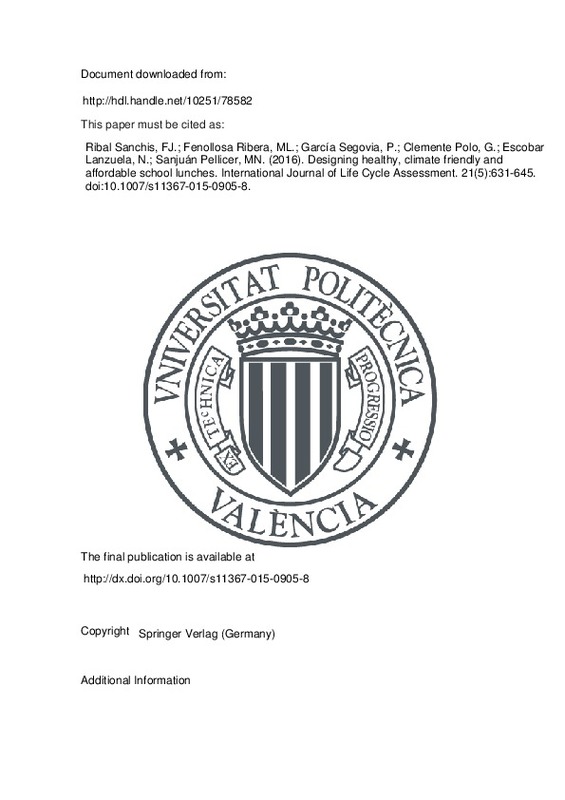AESAN (2011) Estudio de prevalencia de la obesidad infantil “Aladino”. Agencia Española de Seguridad Alimentaria y Nutrición. Ministerio de Sanidad, política social e igualdad. Madrid. http://www.aesan.msc.es/AESAN/docs/docs/notas_prensa/ALADINO_presentacion.pdf . Accesed Sep 2014
BEDCA (2014) Base de datos española de composición de alimentos. http://www.bedca.net . Accesed May 2013
BSI (2011) PAS 2050. Specification for the assessment of the life cycle greenhouse gas emissions of goods and services. Publicly available specification. British Standards Institution, UK
[+]
AESAN (2011) Estudio de prevalencia de la obesidad infantil “Aladino”. Agencia Española de Seguridad Alimentaria y Nutrición. Ministerio de Sanidad, política social e igualdad. Madrid. http://www.aesan.msc.es/AESAN/docs/docs/notas_prensa/ALADINO_presentacion.pdf . Accesed Sep 2014
BEDCA (2014) Base de datos española de composición de alimentos. http://www.bedca.net . Accesed May 2013
BSI (2011) PAS 2050. Specification for the assessment of the life cycle greenhouse gas emissions of goods and services. Publicly available specification. British Standards Institution, UK
Carlsson-Kanyama A, Faist M (2000) Energy use in the food sector: a data survey, AFR Report 291. Stockholm
Carlsson-Kanyama A, González AD (2009) Potential contributions of food consumption patterns to climate change. Am J Clin Nutr 89:1704–1709
Cuervo M, Corbalán M, Baladía E, Cabrerizo L, Formiguera X, Iglesias C, Lorenzo H, Polanco I, Quiles J, Romero de Ávila MD, Russolillo G, Villarino A, Martínez JA (2009) Comparativa de las ingestas dietéticas de referencia (idr) de los diferentes países de la Unión Europea, de Estados Unidos (EEUU) y de la Organización Mundial de la Salud (OMS). Nutr Hosp 24(4):384–414
Drewnowski A (2009) Defining nutrient density: development and validation of the nutrient rich foods index. J Am Col Nutr 28:421S–425S
Ernst and Young (2010) Product carbon footprinting – a study on methodologies and initiatives. Ernst & Young for EU DG Environment, Brussels, Belgium
FAO (2010) Biodiversity and sustainable diets – united against hunger. International Scientific Symposium, Rome, Italy
FEPEX (2014) Federación Española de Asociaciones de Productores Exportadores de Frutas, Hortalizas, Flores y Plantas vivas (Spanish Federation of Associations of Producers Exporters of Fruits, Vegetables, Flowers and living Plants). Importaciones españolas de frutas y hortalizas. Available in: http://www.fepex.es/datos-del-sector/exportacion-importacion-espa%C3%B1ola-frutas-hortalizas . Accesed June 2014
Foster C, Green K, Bleda M, Dewick P, Evans B, Flynn A, Mylan J (2006) Environmental impacts of food production and consumption: a report to the Department for Environment, Food and Rural Affairs. Manchester Bussiness School. Defra, London
Heller MC, Keoleian GA, Willett WC (2013) Toward a life cycle-based, diet-level framework for food environmental impact and nutritional quality assessment: a critical review. Environ Sci Technol 47:12632–12647
ISO (2014) ISO 14067 -- carbon footprint of products -- requirements and guidelines for quantification and communication. International Organization for Standardization, Geneva, Switzerland
Jones D, Tamiz M (2010) Practical goal programming. Springer
Jungbluth N, Tietje O, Scholz R (2000) Food purchases: impacts from the consumers’ point of view investigated with a modular LCA. Int J Life Cycle Assess 5:134–142
Lang T (2005) Food control or food democracy? Re-engaging nutrition with society and the environment. Pub Health Nutr 8(6A):730–737
Macdiarmid JI, Kyle J, Horgan GW, Loe J, Fyfe C, Johnstone A, McNeill G (2012) Sustainable diets for the future: can we contribute to reducing greenhouse gas emissions by eating a healthy diet? Am J Clin Nutr 96:632–639
MAGRAMA (2013) Ministerio de Agricultura Alimentación y Medio Ambiente. Producciones agrícolas. Available at: http://www.magrama.gob.es/es/agricultura/temas/producciones-agricolas/ . Accesed July 2013
Maillot M, Vieux F, Amiot MJ, Darmon N (2010) Individual diet modeling translates nutrient recommendations into realistic and individual-specific food choices. Am J Clin Nutr 91:421–430
Martínez Alvarez JR, García Alcon R, Villarino Marín A, Serrano Morago L, Marrodan Serrano MD (2012) Encuesta nacional sobre comedores escolares y demanda de dietas especiales. Nutr Hosp 27(1):252–255
Moreiras O, Carbajal A, Cabrera L, Cuadrado C (2011) Tablas de composición de alimentos. Ediciones Pirámide. 15.ª ed.
MSC (2008) Guía de Comedores Escolares. Ministerio de Sanidad y Consumo/Agencia Española de Seguridad Alimentaria y Nutrición. Available at: http://aesan.msssi.gob.es/AESAN/docs/docs/publicaciones_estudios/nutricion/guia_comedores_escolares.pdf . Accessed Nov 2014
Nielsen PH, Nielsen AM, Weidema BP, Dalgaard R and Halberg N (2003) LCA food data base. www.lcafood.dk
Protocol, GHG (2011). Product life cycle accounting and reporting standard. World Business Council for Sustainable Development and World Resource Institute
Roches A, Nemecek T, Gaillard G, Plassmann K, Sim S, King H, Milà i Canals L (2010) MEXALCA: a modular method for the extrapolation of crop LCA (and supporting information). Int J Life Cycle Ass 15:842–854
Sanjuan N, Stoessel F, Hellweg S (2014) Closing data gaps for LCA of food products: estimating the energy demand of food processing. Environ Sci Technol 48:1132–1140
Thibert J, Badami MG (2011) Estimating and communicating food system impacts: a case study in Montreal, Quebec. Ecol Econ 70:1814–1821
Tobler C, Visschers VH, Siegrist M (2011) Organic tomatoes versus canned beans how do consumers assess the environmental friendliness of vegetables? Environ Behav 43(5):591–611
Tyszler M, Kramer GFH, Blonk H (2014) Just eating healthier is not enough: studying the environmental impact of different diet scenarios for the Netherlands by linear Programming. Proceedings of the 9th International Conference LCA of Food. San Francisco, USA, 8–10 October
UNICEF España (2014) La Infancia en España. El valor social de los niños: hacia un pacto de estado por la infancia. Available at: http://www.unicef.es/sites/www.unicef.es/files/infancia-espana/unicef_informe_la_infancia_en_espana_2014.pdf . Accessed 20th February 2015
Van Dooren C, Aiking H (2014) Defining a nutritionally healthy, environmentally friendly, and culturally acceptable Low Lands Diet. Proceedings of the 9th international conference LCA of food. San Francisco, USA, 8–10 October
Vanclay JK, Shortiss J, Aulsebrook S, Gillespie AM, Howell BC, Johanni R, Maher MJ, Mitchell KM, Stewart MD, Yates J (2011) Customer response to carbon labelling of groceries. J Consum Policy 34:153–160
Vieux F, Soler L-G, Touazi D, Darmon N (2013) High nutritional quality is not associated with low greenhouse gas emissions in self-selected diets of French adults. Am J Clin Nutr 97:569–583
Weidema BP, Thrane M, Christensen P, Schmidt J, Løkke S (2008) Carbon footprint. J Ind Ecol 12:3–6
[-]







![[Cerrado]](/themes/UPV/images/candado.png)


